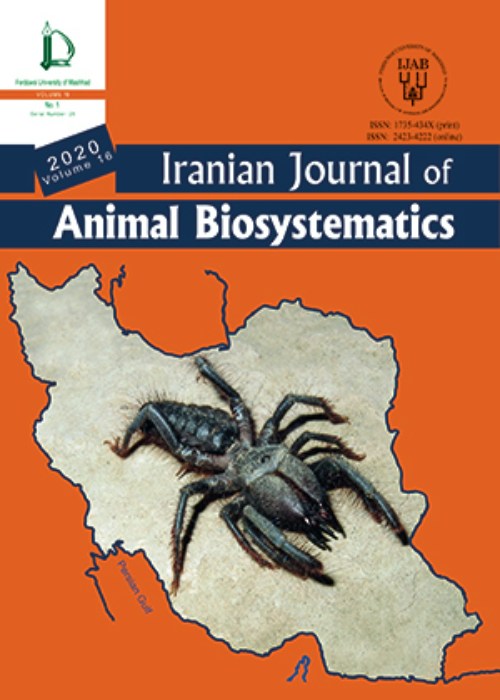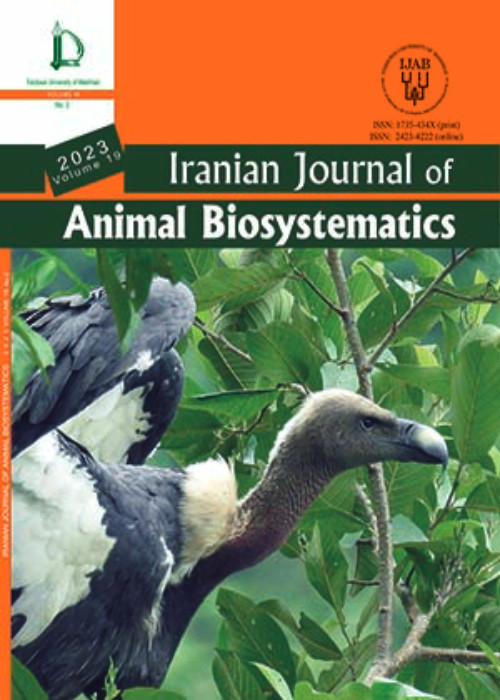فهرست مطالب

Iranian journal of animal biosystematics
Volume:19 Issue: 1, Winter-Spring 2023
- تاریخ انتشار: 1402/08/10
- تعداد عناوین: 6
-
-
Pages 1-12The genus Hottentotta Birula, 1908 is one of the most widely distributed buthid scorpion, with more than 40 described species from Africa, across the Middle East, to India. Currently, the genus is represented by ten morphological species in Iran (H. akbarii, H. jayakari, H. juliae, H. khoozestanus, H. lorestanus, H. navidpouri, H. saulcyi, H. schach, H. sistanensis and H. zagrosensis), all of which endemic or subendemic in Iran. The members of this genus have not been properly studied from the taxonomic point of view. A tool that could contribute to studies scorpiones taxonomic is the geometric morphometry, which is defined as the fusion between geometry and biology (Bookstein, 1982). In this study to the size and shape variations in sternocoxal structure in the genus Hottentotta has been examined using geometric morphometric method. We photographed 100 individuals of Hottentotta genus in Iran. Coordinate (x, y) configurations from landmarks were registered in sternocoxal structures. The results clearly showed divergence in the shape and size of sternocoxal structure among the studied taxa.Keywords: Coxae, Geometry, Hottentotta, Iran, landmark, Sternum
-
Pages 13-21
Iran is a large country with diverse and unique climate and ecology; therefore, it is expected to discover an exceptional fauna with high species diversity by carefully examining the unknown areas. A few taxonomic studies have been so far conducted on the genus Pholcus in Iran. Taxonomic and preliminary phylogenetic evaluation of widespread species of the genus Pholcus from Iran is considered in the present study, based on specimens collected from northern and southwestern parts of the country. A molecular study was undertaken on some representatives of species of the Pholcus phalangioides species-group (cellar spiders) using newly designed primers with 350 bp of partial fragments of mtDNA gene, cytochrome oxidase subunit 1 (COI). These preliminary molecular data in line with morphological identifications using characters related to the copulatory organs presented a total of five distinct clades of Pholcus that four clades were contributed with formerly identified species and one represented a distinct lineage unknown for science.
Keywords: Species delimitation, DNA-based, CO1, morphology, Iran, Pholcus -
Pages 23-32The Bombyliidae family with around 5382 described species is one of the most important families in order Diptera considering their remarkable roles in biological pest control. Species of the family Bombyliidae were monitored in Guilan province in 2019 and 2020. We aimed to evaluate their biodiversity in the grasslands along with the determining Simpson and Margalef indexes. Totally 20 species from 11 genera in 2019 and 17 species from 10 genera in 2020 were identified in eight selected stations. The highest numbers of Bombyliids individuals were observed in Heiran pass station in 2019. Surprisingly the lowest number of individuals also was present in Heiran pass station in 2020. The results of ecological indices also showed the highest Margalef index in Darestan station (2.18) in 2019 and the lowest observed in Bivazen station (0) and Rudbar- Loockhee (0) in 2019 and 2020 respectively. Also, the highest values for the Simpson index were recorded in Bivazen (1) in 2019 and Rudbar- Loockhee (1) in 2020. The lowest values of the Simpson index have been recorded for Amlash (0.13) stations as well. It seems that climate and ecological condition changes in different years clearly affect the insect biodiversity indexes via making changes in their population dynamics.Keywords: Diversity, Bombyliidae, Simpson index, Margalef index, Guilan province
-
Pages 33-45
The eyelid bearing geckos Eublepharidae including six widely disjunct genera and 45 species which are distributed in tropical to temperate habitats of Eurasia, North-Central America and Africa. One of the eublepharid genera is the fat-tailed geckos of the genus Eublepharis Gray, 1827. The specific characters of Eublepharis involves flat basioccipital bone, deep axial pockets (armpit), eyelids well developed and movable, pupil vertical, dorsal small scales juxtaposed larger tubercles. The fat-tailed geckos as a vicariant group, encompass seven secretive, and nocturnal species: E. angramainyu Anderson and Leviton, 1966, E. fuscus Börner, 1974, E. hardwickii Gray, 1827, E. macularius (Blyth, 1854), E. satpuraensis Mirza, Sanap, Raju, Gawai and Ghadekar, 2014, E. pictus Mirza and Gnaneswar, 2022), and E. turcmenicus Darevsky, 1977 which are distributed from Turkey through the Iranian Plateau to India as following: south-eastern Turkey, Syria, Iraq, Iran, Pakistan, Afghanistan, Turkmenistan, and north-eastern and central India in a variety of habitats from dry karst topography regions with gypsum deposits and clay-gravel soil to stony foothills. The data used for the distribution maps were based on all available bibliographic records, and personal field observations. The results showed that among the three species located in Iran, E. angramainyu has the most widespread distribution and habitat diversity, and E. macularius has a very limited distribution in the border of Iran and Afghanistan. The range of species distribution depends on various factors including behavioral mechanisms of superior habitat selection, interactions with other living organisms and physico-chemical factors.
Keywords: Eublepharis, Eyelid geckos, Eublepharidae, distribution, Asia -
Pages 47-74Many studies conducted on range of animals showed that morphology is related to habitat. In the present study, we aimed to examine the morphological characteristics of species assigned to the genus Ophiomorus in Iran. Seventy-one specimens from throughout the range of distribution in the central plateau of Iran were investigated. Eleven morphometric and four meristic variables were analyzed independently. Multivariate analyses were performed using canonical variate analysis (CVA) and principal component analysis (PCA). The results showed that there is significant morphological differentiation between three species groups brevipes, tridactylus, and punctatissimus in this genus in relation to habitat choice. ANOVA results showed that 14 morphological characters (SVL, HL, HW, HH, SL, LF, LA, LFL, LFH, LHF, NSL, NDSB, NMC, and NIL; 10 metric and four Meristic) were significantly different among all Ophiomorus species, which based on this, TL did not show a significant difference among species. Finally, we assigned three species groups based on limb reduction (especially fingers), and habitat surface (comparison based on habitat observations) for all Ophiomorus species in Iran. In addition, using newly applied morphological characteristics we proposed an updated identification key for the genus.Keywords: Adaptation, Biogeography, morphology, Ophiomorus, Iranian Plateau, Snake Skinks
-
Pages 71-101Calomyscidae is a monotypic family of muroid rodents with nine valid allopatric species distributed in southwestern Asia of which seven species have been so far recognized from Iran. The western and southern Zagros Mountains were thought to be home to a single species, Calomyscus bailwardi, but new researches revealed that the region is also home to four highly divergent molecular lineages. One of them was recently described as a new species (C. behzadi) but the taxonomic position of the other lineages remained unclear. Here we did an extensive sampling in southern Iran (2017-2018), during which 99 Calomyscus specimens were collected. Based on an integrated approach including karyotypic, mitochondrial as well as morphological data, we describe Calomyscus kermanensis sp. nov. as a new endemic species from the southern Zagros Mts (including Kohgiluyeh and Boyer-Ahmad, Fars, Kerman, Yazd and Hormozgan provinces), in the region that was previously thought to be occupied by C. bailwardi. The new species emerged as a new lineage with high intraspecific mtDNA and chromosome variations. The multivariate and univariate statistical analyses of craniodental measurements also separated C. kermanensis sp. nov. from other examined Calomyscus species with the highest maximum cranial height being the most distinctive of its craniodental features.Keywords: Calomyscus, Karyotype, Mitochondrial Genes, morphometry, taxonomy, phylogeny, Zagros Mountains, Iran


